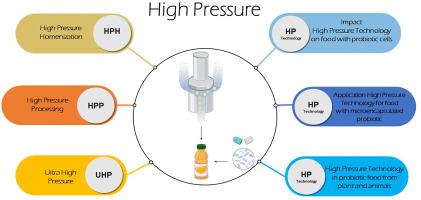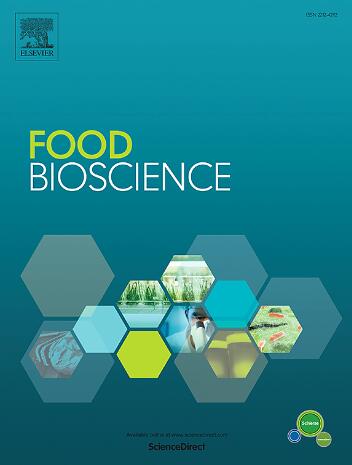Perspectives of high-pressure technology in probiotic food production: A comprehensive review
IF 4.8
1区 农林科学
Q1 FOOD SCIENCE & TECHNOLOGY
引用次数: 0
Abstract
Due to their health benefits, the growing demand for functional foods, including probiotics, is driving the market. Although several probiotic foods are available, their incorporation presents challenges due to the sensitivity of probiotics to processing conditions. Thus, the adoption of non-thermal technologies for microencapsulation and processing, such as high pressure, has been increasingly studied to preserve strains' viability and resistance. There are types of processing: high-pressure homogenization (HAP) and high hydrostatic pressure processing (HPP), depending on the pressure values applied and their specific purposes. This review explored the potential of high-pressure (HP) technology as an alternative to heat treatments for developing probiotic foods containing free and microencapsulated microorganisms, considering recent searches in ScienceDirect, Scopus, Web of Science, PubMed, and Google Scholar. This technology increases the viability and resistance of probiotics during processing, improving their functionality, maintaining the nutritional and sensory properties of the food, inactivating pathogenic and spoilage microorganisms and enzymes, and increasing the safety and shelf life of the food, being efficient for the microencapsulation of probiotics, providing them with protection and stability and enabling the development of innovative functional products. New wall materials such as natural polysaccharides and vegetable proteins have been studied for high-pressure microencapsulation, standing out for their biocompatibility, biodegradability, food safety, and desirable functional properties. HP technology presents itself as a promising alternative in developing probiotic foods from plant or animal matrices, considering free or microencapsulated microorganisms, enabling the development of a functional, safe, stable, innovative, and high-quality food.

益生菌食品生产中高压技术的前景:综述
由于益生菌对健康有益,包括益生菌在内的功能性食品需求不断增长,推动了市场的发展。虽然市面上有多种益生菌食品,但由于益生菌对加工条件的敏感性,将其添加到食品中面临着挑战。因此,人们越来越多地研究采用高压等非热技术进行微囊化和加工,以保持菌株的活力和抵抗力。根据所使用的压力值和具体用途的不同,可分为高压均质化(HAP)和高压静压处理(HPP)两种处理方式。本综述考虑到最近在 ScienceDirect、Scopus、Web of Science、PubMed 和 Google Scholar 上的搜索结果,探讨了高压(HP)技术作为热处理替代品的潜力,以开发含有游离和微囊微生物的益生菌食品。这种技术能提高益生菌在加工过程中的存活率和抵抗力,改善其功能,保持食品的营养和感官特性,灭活致病和腐败微生物及酶,延长食品的安全性和保质期,是益生菌微胶囊化的有效方法,能为益生菌提供保护和稳定性,促进创新功能产品的开发。人们研究了用于高压微胶囊技术的新型壁材,如天然多糖和植物蛋白,它们具有生物相容性、生物可降解性、食品安全性和理想的功能特性。在利用植物或动物基质开发益生菌食品方面,高压微胶囊技术是一种很有前途的选择,它可以考虑使用游离或微胶囊微生物,从而开发出功能性、安全、稳定、创新和高质量的食品。
本文章由计算机程序翻译,如有差异,请以英文原文为准。
求助全文
约1分钟内获得全文
求助全文
来源期刊

Food Bioscience
Biochemistry, Genetics and Molecular Biology-Biochemistry
CiteScore
6.40
自引率
5.80%
发文量
671
审稿时长
27 days
期刊介绍:
Food Bioscience is a peer-reviewed journal that aims to provide a forum for recent developments in the field of bio-related food research. The journal focuses on both fundamental and applied research worldwide, with special attention to ethnic and cultural aspects of food bioresearch.
 求助内容:
求助内容: 应助结果提醒方式:
应助结果提醒方式:


